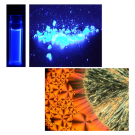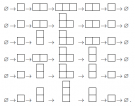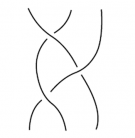Present research subject: Representation theory of association schemes
In my school days, the main field of my research was "representation theory of finite groups", but it was changed to "theory of finite association schemes", especially "representation theory of association schemes", by one mathematical problem. When I started studying theory of association schemes, no specialist was near me, and thus it was not so easy. First, I tried to make small examples (This calculation developed into classification of association schemes by a computer). By examples, we had one natural problem. It is well known that finite groups of prime order are cyclic. How about association schemes of prime order? Known examples of association schemes of prime order are algebraically isomorphic to cyclotomic schemes. This problem was my main problem for a long days.
In 2004, a symposium on ring theory was held in Matsumoto. At the party of the symposium, Professor Katsuhiko Uno (Osaka Kyoiku University) said me that "We must return to Ricard. Brauer", Richard Brauer (1901-1977, Germany) is the greatest pioneer of modular representation theory of finite groups. We could find an idea in his paper, and we got the following big result.
Theorem (Hanaki-Uno 2006)Association schemes f prime order are commutative. Moreover, if the minimal splitting field of an association scheme of prime order is abelian, then the association scheme is algebraically isomorphic to the cyclotomic scheme.
The proof was based on modular representation theory and was a new method for the study of association schemes. There is a famous question by E. Bannai and T. Ito : Is the minimal splitting field of a commutative association scheme abelian? After our result, T. Komatsu and E. Bannai showed a possibility of the existence of an association scheme of prime order with non-abelian splitting field. The question is still open.
At present, it seems to be impossible to classify all association schemes of prime order. I am trying to establish representation theory of association schemes. Especially, I am interested in modular standard representations.
Research Area: Algebraic Combinatorics - association schemes
In 1930's, R. A. Fisher considered basic parts of combinatorial designs to apply them for agricultural experiments. Roughly speaking, the aim of design theory is to find good small subsets which approximate the whole set.
In 1940's, C. E. Shannon considered theory of error correcting codes. The theory can correct noise of communications. It has a very important role in information technology.
In 1973, P. Delsarte wrote a celebrated paper. He showed that both theories of combinatorial designs and error correcting codes can be understood in the theory of association schemes. Some mathematicians say that the paper is the starting point of this area, algebraic combinatorics.
On the other hand, in 1970's, D. G. Higman studied the theory of coherent configurations as a generalization of finite group theory. It is a non-commutative version of the Delsarte's theory. In my study, association schemes are not assumed to be commutative, and are just homogeneous coherent configurations considered by Higman.
Association schemes are defined by a combinatorial way, and thus, many their research are done by combinatorial ways. However, if we consider big objects, then the study becomes very difficult. We need some "rough" arguments to deal with big objects. From an association scheme, we can define an algebra, called the adjacency algebra. The algebra cannot reconstruct the association scheme. Thus some informations are lost. However, we could find some new results by considering adjacency algebras. Further development of a study is expected.
Association schemes
Let $X$ be a finite set, and let $S$ be a partition of $X\times X$. Namely,
$$X\times X=\bigcup_{s\in S} s$$
is a disjoint union of non-empty subsets. The pair $(X,S)$ is said to be an association scheme if the following three conditions satisfied:
(1) $1:=\{(x,x)\mid x\in X\}$,
(2) for every $s\in S$, $s^*:=\{(y,x)\mid (x,y)\in s\}\in S$, and
(3) for $s,t,u\in S$, there exists a non-negative integer $p_{st}^u$ such that
$$\sharp\{z\in X\mid (x,z)\in s,\ (z,y)\in t\}=p_{st}^u$$
whenever $(x,y)\in u$.
The order of an association scheme $(X,S)$ is $|X|$. If $p_{st}^u=p_{ts}^u$ for all $s,t,u\in S$, we say that the association scheme is commutative. For an association scheme $(X,S)$ and a field $K$, we can define the adjacency algebra of $(X,S)$ over $K$ with structure constants $\{p_{st}^u\}$. Adjacency algebras of commutative association schemes are commutative.
If we consider the complex number field $\mathbb{C}$ as a coefficient field, then the adjacency algebra $\mathbb{C} S$ is semisimple and character theory is very effective. Adjacency algebras over a positive characteristic field are not necessary semisimple and their study is difficult. In this case, we call them modular adjacency algebras.






